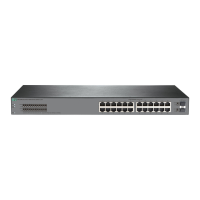90
Field Description
Flags
LACP state flags. This field is one byte long, represented by ABCDEFGH from
the least significant bit to the most significant bit. A letter appears when its bit is 1
and does not appear when its bit is 0.
• A—Indicates whether LACP is active on the port. 1 indicates active. 0
indicates passive.
• B—Indicates the LACP timeout interval. 1 indicates the short timeout
interval. 0 indicates the long timeout interval.
• C—Indicates whether the sending system considers that the link is
aggregatable. 1 indicates yes. 0 indicates no.
• D—Indicates whether the sending system considers that the link has been
aggregated. 1 indicates yes. 0 indicates no.
• E—Indicates whether the sending system considers that the link can collect
frames. 1 indicates yes. 0 indicates no.
• F—Indicates whether the sending system considers that the link can
distribute frames. 1 indicates yes. 0 indicates no.
• G—Indicates whether the RX state machine of the sending system is in
default state. 1 indicates yes. 0 indicates no.
• H—Indicates whether the RX state machine of the sending system is in
expired state. 1 indicates yes. 0 indicates no.
Aggregate Interface Name of the aggregate interface.
Aggregation Mode
Aggregation group type:
• S—Static.
• D—Dynamic.
Management VLANs
Management VLANs. If no management VLANs are specified, this field displays
None
.
This field is not supported in the current software version.
System ID
Local system ID, containing the local system LACP priority and the local system
MAC address.
Local
Information about the local end:
• Port—Port type and number.
• Status—Port state, which can be Selected, Unselected, or Individual.
• Priority—Port priority.
• Index—Port index.
• Oper-Key—Operational key.
• Flag—LACP state flag.
NOTE:
For static aggregation groups, the Flag field is not displayed.
Remote
Information about the peer end:
• Actor—Type and number of the local port. This field displays the (R) flag
next to the port if its peer port is the reference port.
• Priority—Priority of the peer port.
• Index—Index of the peer port.
• Oper-Key—Operational key of the peer port.
• System ID—System ID of the peer end.
• Flag—LACP state flag of the peer end.
interface bridge-aggregation
Use interface bridge-aggregation to create a Layer 2 aggregate interface and enter its
view, or enter the view of an existing Layer 2 aggregate interface.

